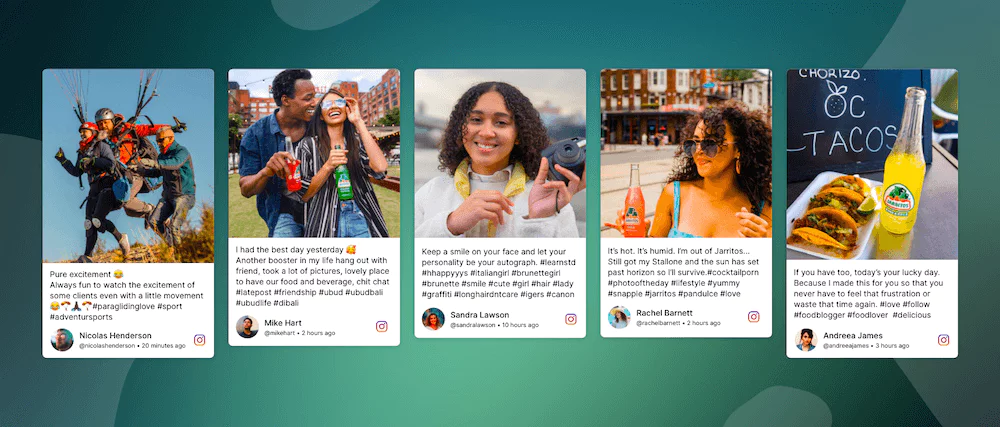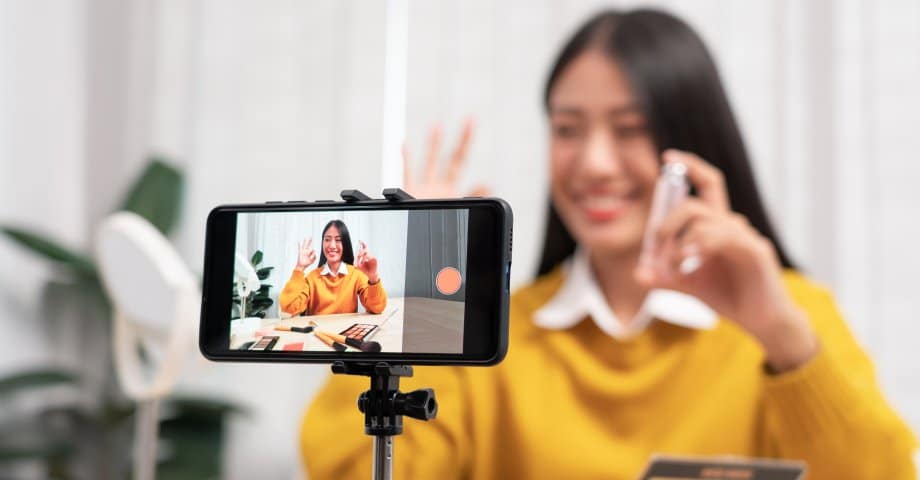User Generated Content Is The Future of Advertising
Table Of Contents
User-Generated Content (UGC) Is High In Demand
In a world where nearly everyone owns a mobile phone, we have the ability to make content with the click of a button. Though traditionally, brands would pay thousands, if not millions, to a team of professional videographers, photographers, and graphic designers, they are now realizing the power that UGC can have to resonate with their target audience at a fraction of the cost.
While influencer marketing is still a powerful strategy for brands to utilize, hiring influencers comes at a much higher cost and may not be as successful as UGC created by micro-influencers or the average social media user. In this blog, Hollywood Branded discusses the concept of UGC, how it compares to other forms of advertising, such as celebrity endorsements and influencer marketing, and how it can be beneficial for your brand.

The Lowdown On UGC
User-generated content, known as UGC or UCC (user-created content), is not a new concept, but it only recently has become a serious contender in the world of brand/product advertising. Science has shown that humans are natural storytellers and that consumers respond positively to branding or advertising that takes the form of storytelling. A study from Nature Communications states, “Storytelling is a powerful means of fostering social cooperation, and it pays valuable dividends to the storytellers themselves, improving their chances of being chosen." Brands such as Coca-Cola and Marlboro have been using fictional storytelling since the advent of advertising, and while they were initially successful, consumers' desires changed from wanting a fictional story to wanting to know about real customer experiences with the brand. This shift coincided with the rise in popularity of the internet and social media, which made it increasingly easy for consumers to share their experiences with their friends, family, and acquaintances who follow them.
UGC is any form of content, including reviews, videos, images, graphics, audio, etc., that is entirely created by independent contractors who are users of social media as well as users of the brand they are creating the content for. There are numerous benefits of brands using UGC; it has become increasingly common and even the preferred method of advertising for some brands. More than 86% of companies today use user-generated content as part of their marketing strategy, and 72% believe that it significantly improves their engagement.

Photo Credit: adweek.com
UGC VS Influencer Marketing VS Celebrity Endorsements
As mentioned previously UGC is any form of content that has been entirely created by a user. It can be either posted organically by the user on their online platforms, such as social media, or they may be contracted by a brand to create content for them to use on their online platforms. These users most often do not have enough followers to qualify as social media influencers. However, they may be natural storytellers and be very skillful at photography, videography, graphic design, or copywriting. If a creator genuinely likes a product or brand, they may independently post product reviews or other forms of content to their social media with no expectation of being noticed by the brand. When a brand finds content that aligns with its style and social media strategy, it can enter into negotiations with the creator to obtain the rights to the content. The brand may sometimes be able to obtain the rights to the content absolutely free, or they may agree to PR gifting or monetary compensation to the creator. On the other hand, a brand may contract a user to create content for them in a more collaborative manner, such as giving them certain parameters and guidelines for the content they would like. This form of UGC is typically paid, though many creators agree to PR gifting as a form of payment.

Photo Credit: Jennifer Morris | taggbox.com
UGC differs from influencer marketing in that the user creating the content is not an influencer, meaning they do not have a social media following large enough to qualify them as a nano, micro, or macro influencer. An influencer can create UGC, BUT a person creating UGC may not be an influencer. Influencer marketing still remains a widely used form of advertising for brands and is very successful as brands are able to reach a specific target audience through the influencer's platform. However, when a brand contracts an influencer to make a post on their social media, this does not always guarantee that the brand will have the rights to the content being posted; thus, they may not be able to repurpose it. In order for the brand to obtain the rights to the content, they may have to pay an additional fee which may be very high depending on how big of a following the influencer has (e.g., a macro influencer). This may be the biggest drawback of influencer marketing in comparison to UGC.
Then there are celebrity endorsements which have been a popular choice of marketing for brands even prior to the proliferation of social media. Similarly to influencer marketing, brands will enter into a contractual agreement with a celebrity which requires them to publicize their affinity and love of a product or brand. This can be in the form of a social media image, video, etc. Celebrities use their fame and influence to bring attention to the brand and boost sales if that’s the desired outcome. This is typically the most costly option, as the more famous the celebrity, the more they will charge. In addition to the hefty price tag associated with celebrity endorsements, the brand isn’t guaranteed the rights to the content posted by the celebrity, thus posing the same issue as influencer marketing. Furthermore, despite celebrities having a large following, their audience may not fully trust their opinion as they may see the endorsement as a ‘cash grab,’ meaning the celebrity is only endorsing the product because they are being paid to, not because they actually like the product.
Benefits Of UGC To Brands
So as you can see, when compared to the other forms of advertising previously mentioned as well as traditional advertising, UGC has numerous benefits. Off the bat, UGC is 20% more influential than any other kind of media when it comes to millennial buyers.
UGC Will Save Your Brand $$$

Photo Credit: embedsocial.com
UGC is great for smaller, up-and-coming brands that may not have the large budget of a big company to be able to afford an in-house marketing team or hire an advertising agency. On average, UGC can save brands the expense of a dedicated content producer, which is around $72,000. Smaller businesses also may not be able to afford the steep costs associated with celebrity endorsements or even influencer marketing.
Even for larger brands that may have a bigger budget, UGC allows a brand to cut costs through omnichannel marketing, which they can then reallocate their savings to other aspects of the business. “Brands don’t have to worry about creating different content for each of their social platforms, their customers can do it for them. When brands need to create campaigns across each platform, they can source and repurpose content to fit every platform they want to post it on.”
UGC Improves Consumer Relations and Experience
UGC can also be leveraged by brands to improve their relationship with consumers by building trust—84% of this generation are more likely to trust a company if it uses actual customers in its ads—and credibility. The point of UGC is that it feels more organic and genuine than typical ads or even then an influencer making a post, 75% of respondents claim that UGC makes content more authentic, and 92% of consumers trust recommendations from other people, even if it’s people they don’t know. UGC allows a brand to appear relatable, building an intimate connection with its audience.
Finally, when it comes to online shopping, it’s clear that UGC is the best choice for brands. Websites utilizing UGC saw a 20% increase in return visitors and recorded a 90% increase in time spent on-site. Additionally, 93% of customers believe UGC is very helpful when making a purchasing decision. When it comes to SEO and online advertising, the benefits can be seen there too. A recent study found that ads based on user-generated content get 4 times the click-through rate and a 50% drop in cost-per-click in comparison to non-UGC ads.
Eager To Learn More?
UGC is quickly becoming the go-to marketing strategy for brands, small and large, for the reasons previously listed. Learn more about how your brand can use UGC and the benefits in the following blog posts.
- 5 Facts for Advertising to Millennials
- 6 Tips for Businesses to Reach to Gen Z
- TikTok Should Be Your Next Social Media Marketing Strategy
- Transmedia Storytelling As A Marketing Tactic
- Creating Content With Influencer Marketing
Interested in learning the ins and outs of making influencer and celebrity marketing work? Access our full-length videos, transcripts, audio files, infographics, and more!! Hollywood Branded's Influencer Marketing School advances your influencer marketing game. These courses are for brand and agency marketers to provide insight into how influencer marketing strategies work and the best practices and strategies to make them do so.








